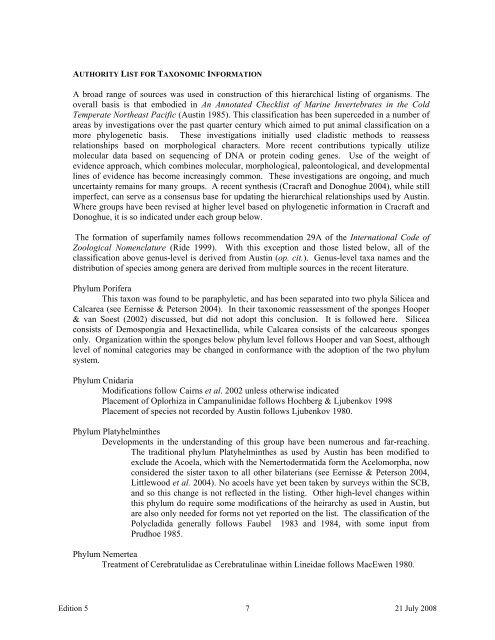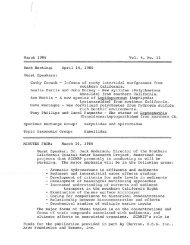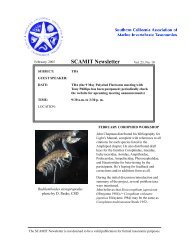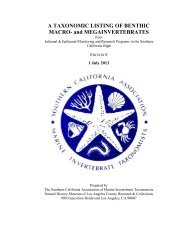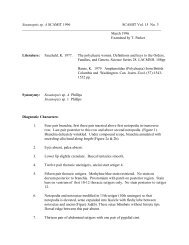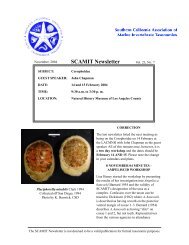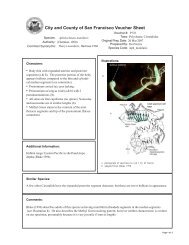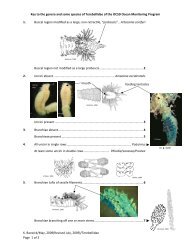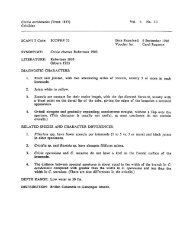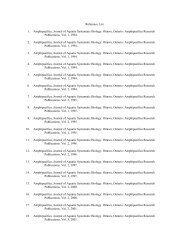Download - scamit
Download - scamit
Download - scamit
Create successful ePaper yourself
Turn your PDF publications into a flip-book with our unique Google optimized e-Paper software.
AUTHORITY LIST FOR TAXONOMIC INFORMATION<br />
A broad range of sources was used in construction of this hierarchical listing of organisms. The<br />
overall basis is that embodied in An Annotated Checklist of Marine Invertebrates in the Cold<br />
Temperate Northeast Pacific (Austin 1985). This classification has been superceded in a number of<br />
areas by investigations over the past quarter century which aimed to put animal classification on a<br />
more phylogenetic basis. These investigations initially used cladistic methods to reassess<br />
relationships based on morphological characters. More recent contributions typically utilize<br />
molecular data based on sequencing of DNA or protein coding genes. Use of the weight of<br />
evidence approach, which combines molecular, morphological, paleontological, and developmental<br />
lines of evidence has become increasingly common. These investigations are ongoing, and much<br />
uncertainty remains for many groups. A recent synthesis (Cracraft and Donoghue 2004), while still<br />
imperfect, can serve as a consensus base for updating the hierarchical relationships used by Austin.<br />
Where groups have been revised at higher level based on phylogenetic information in Cracraft and<br />
Donoghue, it is so indicated under each group below.<br />
The formation of superfamily names follows recommendation 29A of the International Code of<br />
Zoological Nomenclature (Ride 1999). With this exception and those listed below, all of the<br />
classification above genus-level is derived from Austin (op. cit.). Genus-level taxa names and the<br />
distribution of species among genera are derived from multiple sources in the recent literature.<br />
Phylum Porifera<br />
This taxon was found to be paraphyletic, and has been separated into two phyla Silicea and<br />
Calcarea (see Eernisse & Peterson 2004). In their taxonomic reassessment of the sponges Hooper<br />
& van Soest (2002) discussed, but did not adopt this conclusion. It is followed here. Silicea<br />
consists of Demospongia and Hexactinellida, while Calcarea consists of the calcareous sponges<br />
only. Organization within the sponges below phylum level follows Hooper and van Soest, although<br />
level of nominal categories may be changed in conformance with the adoption of the two phylum<br />
system.<br />
Phylum Cnidaria<br />
Modifications follow Cairns et al. 2002 unless otherwise indicated<br />
Placement of Oplorhiza in Campanulinidae follows Hochberg & Ljubenkov 1998<br />
Placement of species not recorded by Austin follows Ljubenkov 1980.<br />
Phylum Platyhelminthes<br />
Developments in the understanding of this group have been numerous and far-reaching.<br />
The traditional phylum Platyhelminthes as used by Austin has been modified to<br />
exclude the Acoela, which with the Nemertodermatida form the Acelomorpha, now<br />
considered the sister taxon to all other bilaterians (see Eernisse & Peterson 2004,<br />
Littlewood et al. 2004). No acoels have yet been taken by surveys within the SCB,<br />
and so this change is not reflected in the listing. Other high-level changes within<br />
this phylum do require some modifications of the heirarchy as used in Austin, but<br />
are also only needed for forms not yet reported on the list. The classification of the<br />
Polycladida generally follows Faubel 1983 and 1984, with some input from<br />
Prudhoe 1985.<br />
Phylum Nemertea<br />
Treatment of Cerebratulidae as Cerebratulinae within Lineidae follows MacEwen 1980.<br />
Edition 5 7 21 July 2008


